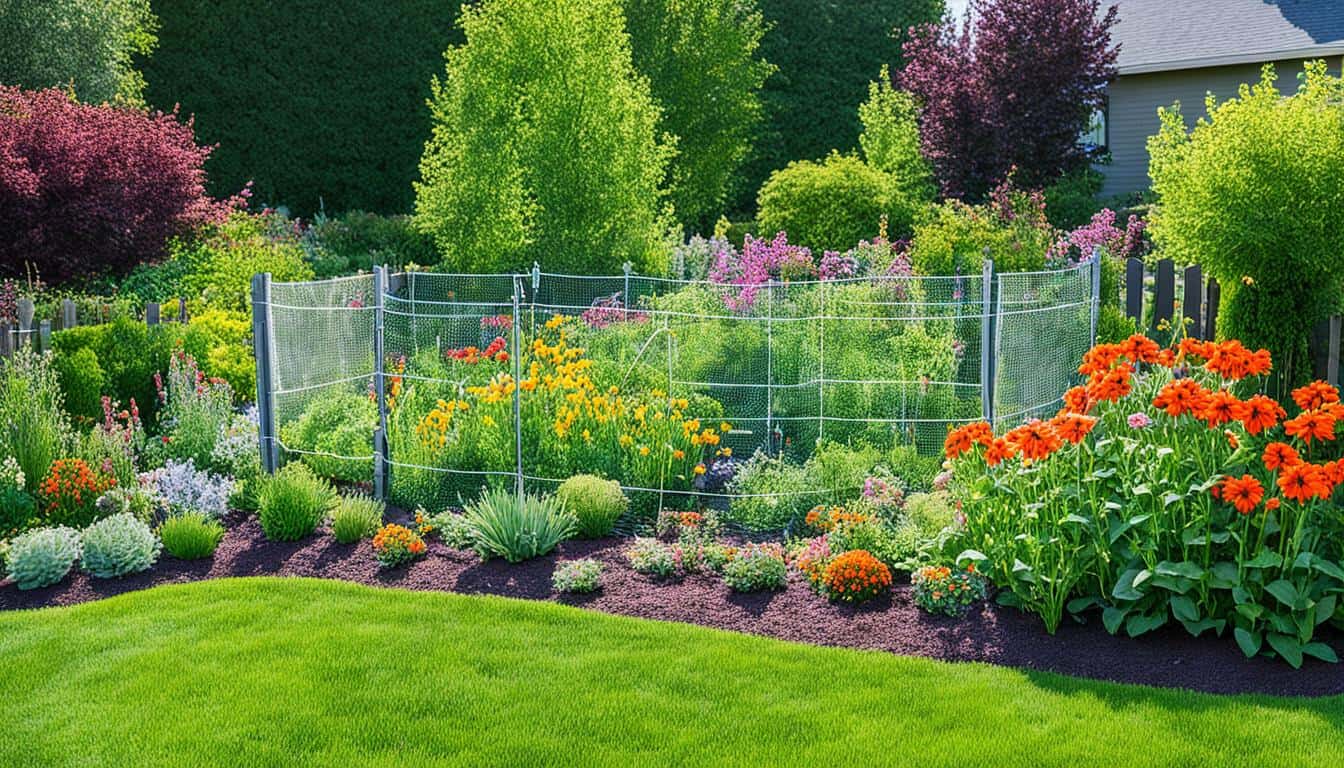Gardens from city to countryside in the USA often get visitors looking for a snack. Dr. Michael Mengak, a wildlife expert, recommends using several approaches together. This mix helps keep gardens safe from hungry visitors.
First off, building a fence is a great start to keep animals out. The fence’s height and material matter. Go for chicken wire that’s 18 inches high for rabbits. Use a four to five-foot fence to stop deer from getting in.
If you’re worried about groundhogs, add an angled top to your fence and bury it deep.
Using repellents can also help. Choose ones that either smell bad or taste bad to the animals. But remember, you have to use these early and often. Sometimes wild animals get used to them.
Stories say home tricks work, but there’s not a lot of science behind them. Things like putting your vegetable garden in a raised bed can help. As can putting plants in a smart way to protect them from certain animals.
You could also try scaring animals away with devices that spray water when they move. But, these gadgets need to change up their tactics now and then to keep animals on their toes.
It’s important to study what kinds of animals visit your place and what they like to eat. Doing so helps you choose the best mix of ways to keep them away while still sharing your space with these wild neighbors.
Understanding the Wildlife Problem in Your Area
To control garden wildlife, you must know what pests are around and what they do. This info will help prevent harm to your garden. It’s important to know your local wildlife’s habits.
Identify the Common Garden Pests
Start by finding out which pests are common in your area. You might see rabbits, deer, groundhogs, and various birds. Knowing what they like and where they go can help protect your garden.
Behavioral Patterns of Wildlife
Wildlife each act in their own way around gardens. Rabbits usually target young plants. Deer change their diets based on what’s available. Groundhogs like to dig and can climb, presenting a challenge. Understanding these behaviors is key to keeping your garden safe.
Damage Assessment
It’s crucial to regularly check your garden for damage and identify the pests responsible. This approach allows you to act swiftly and accurately against the pests. Local university extension services can offer great advice and help for stopping wildlife harm in your garden.
Building Effective Fencing for Garden Protection
Making a strong fence is key to keeping creatures away from your garden. It’s important to know what animals you’re trying to stop. This way, your plants will be better shielded. For rabbits, deer, or groundhogs, different fences work best. Here are some good wildlife exclusion methods for each one:
Fencing for Rabbits
For rabbit defense, at least an 18-inch high fence with one-inch openings works. Chicken wire works well. You can also cover plants with wire to keep rabbits away. Doing this early stops rabbits from ruining your garden.
Deer Fencing Solutions
Deer can jump high, so an 8-foot fence might be needed in deer-heavy areas. Use strong materials for the fence. Including wildlife exclusion methods, like not letting deer see through the fence, can help too. They’re less likely to jump over.
Groundhog and Small Critter Barriers
Keeping groundhogs out needs a fence with a special design. A four-foot fence with an angle and buried part stops them from climbing or digging. Use mesh to secure the bottom against small critters. Matching the fence to your target animal is key to protecting your garden.
Put up your fence before you plant. This stops animals from being drawn to your garden. With this, you help your plants grow undisturbed, leading to a great harvest.
Planting Strategies to Deter Wildlife
When you want to keep wildlife away from your yard, picking the right plants and where they go is important. Choose plants that animals don’t like. This way, your garden can stay healthy and free from damage.
Choosing Less Appealing Plants
Choosing plants that have strong smells, rough leaves, or bitter tastes can help. Animals find these kinds of plants less appealing. For instance, herbs with strong smells and rough leaves can stop pests from eating your plants. By adding these plants to your garden, you build a natural defense.
Companion Planting
Companion planting is a smart way to keep pests at bay. It means putting certain plants together. This can confuse pests, keeping them away. Mix plants pests like to eat with ones they don’t like. This creates a natural balance that protects your garden.
Elevated garden beds can also keep plants safe from low-to-ground pests like rabbits. It’s good to get advice from local plant experts when choosing and placing your plants. Following these tips will help your garden stay safe from unwanted animal visitors.
Using Natural and Commercial Repellents
Keeping your garden safe from animals involves using both natural and store-bought repellents. This can work well, especially if you’re always on top of it.
Taste Repellents
Taste repellents have capsaicin, which makes plants taste spicy. Animals won’t want to eat them more than once. This makes your garden a no-go zone for pests.
Odor Repellents
Some repellents use sulfur smells, like those of predators, to scare animals. They might also smell nice to humans with mint or cinnamon. This keeps critters away by making them think they’re being hunted.
Application Tips and Tricks
To get the most out of these products, apply them regularly, about every week or after it rains. Mixing up the types of repellents can also confuse pests. For example, try one kind this week and another next week.
How do you protect your garden from wildlife in the USA?
Keep critters away from your garden with a mix of methods. Wildlife biologist Michael Mengak says it’s good to use several ways together. Try things like fences, repellents, and stuff that scares animals off.
Fences can be designed to match the animals in your area. Put up a chicken wire fence for rabbits and a taller one for deer. Don’t forget groundhogs need a special barrier to stop them from digging under.
There are lots of wildlife repellents. Some smell bad, while others taste bad. Use them a lot at first, before the animals think your garden’s food.
You can also try things that move or make noise, like motion sensors. Remember to change where you put them every so often. Raised garden beds and carefully placing your plants can also help a lot.
It’s smart to learn about the animals near you and what they like. Then, you can plan better to protect your garden. By using many strategies together, you can better safeguard your plants.
Barrier Methods: Netting and Cages
Netting and cages can be great for keeping wildlife out of your garden. They protect against birds and other animals that can harm your plants.

Bird Netting Options
Bird netting creates a cover over your plants to stop birds from eating the fruits. Go for durable nettings like AviGard. These let light and water in while keeping birds away.
Using Row Covers
Row covers shield your seedlings from animal nibbles. But remember to take them off when plants need to pollinate. This keeps your plants safe while helping them grow.
Solid Walls and Structures
Walls and raised beds act as a barrier, especially against rabbits. Make sure these barriers are high enough. This stops animals from jumping over. If you’re dealing with groundhogs, adding a floppy top will keep them from climbing over.
Electronic and Scare Tactics
Gardening safely involves using both electronic garden animal deterrents and scare tactics. For instance, the motion-activated water sprayer is a hit. It surprises animals and keeps them away. To make these work better, move them around often and use more than one.
Another good strategy is using sound machines. These machines make sounds that scare wildlife. You can also use shiny stuff like tapes and mirrors. They reflect light in a way that makes animals run off.
Setting up fake predators in your garden can also help. Placing fake owls or snakes can make animals feel the garden is not safe for them. It’s important to not let animals get used to any of these methods. So, move them and change them often.
| Electronic Deterrents | Scare Tactics |
|---|---|
| Motion-activated water sprayers | Auditory devices emitting distress calls |
| Ultrasonic repellers | Reflective items |
| Light deterrents | Decoy predators |
Professional Wildlife Control Services
Using professional garden wildlife control services is key when you face persistent or dangerous wildlife. These specialists know how to deal with wildlife issues better than DIY methods can. They use their knowledge, tools, and experience.
When to Call a Professional
If you find yourself continuously dealing with pests like groundhogs or armadillos, it may be time for professional help. You might have tried stopping them on your own but without luck. In these cases, it’s wise to turn to experts.
Also, certain animals can be risky or are legally protected. For these reasons, expert help is your best bet.
Services Offered
These expert services don’t just end at removal. They offer humane trapping, strategies to keep animals out, and tips to prevent future problems. This means they not only get rid of the animals. They also educate you on how to keep your garden safe in the future.
Adopting a Multi-Layered Approach
A multi-layered strategy is key for gardeners who want to keep wildlife away. By using many different methods, you cover all your bases. This approach is the best for keeping your garden safe all year.
Combining Methods for Best Results
To protect your garden, use a mix of fencing, repellents, and scare tactics. This stops animals from getting too used to just one kind of deterrent. By combining these, you create strong defenses around your plants.
Seasonal Adjustments
As seasons change, so should your protection plan. In spring, focus on making barriers stronger and using more repellent. When it gets colder, check and change your scare tactics to keep wildlife away. This keeps your garden safe throughout the year.
Monitoring and Maintenance
Keeping an eye on your protection methods is vital. Check fences, refill repellents, and move scare devices to keep them working well. Watching wildlife and how your garden reacts helps you make smart changes. This makes your garden a less attractive place for unwanted visitors.
DIY and Home Remedies for Garden Protection
Trying out DIY exclusion techniques and using home remedies is smart and saves money. Things like soap shavings and human hair might keep some animals away. But, we’re unsure how well they work based on science. Still, they can help when used with other methods.
Building your own barriers is a solid choice. Use materials like chicken wire for fences. You can make these barriers fit your garden perfectly. This keeps animals like rabbits and deer away without spending too much. You can also protect plants by putting cages around them.
Using homemade solutions allows you to adjust to your garden’s needs. For example, hanging pie plates can scare birds off. Similarly, making sprays with garlic or hot pepper can stop some animals from eating your plants. Although not all of these have been proven, many people say they work. Try these along with other strategies for better results.
FAQ
How can I deter critters from my garden?
To keep critters away, use fencing, repellents, and scare tactics. Fence your garden with chicken wire or a deer fence. For small to large animals, these physical barriers work well. You can also use taste and odor repellents.
What are the most common garden pests in the USA?
In the USA, rabbits, deer, groundhogs, and birds are common pests. Knowing the pests in your area helps you protect your garden better.
How do I build a fence to keep rabbits out of my garden?
For rabbits, build an 18-inch high fence with one-inch openings. This stops them from getting in. Use chicken wire for this barrier.
What type of fencing is suitable for deer control?
Deer need fences that are 8 feet high to keep them out. Use sturdy materials like woven wire. This keeps your garden safe in deer-populated areas.
How can I prevent groundhogs from entering my garden?
To stop groundhogs, use a 4-foot tall fence with an angled top. Also, dig it into the ground deep enough. It must be stable and angled outward well to work.
Which plants are naturally less appealing to wildlife?
Vegetation with strong smells, rough feels, or bitter tastes don’t attract pests. Think about plants with fuzzy leaves or strong smells like certain herbs. These can keep animals away.
What is companion planting and how can it help deter wildlife?
Companion planting puts certain plants together to confuse or repel pests. It uses nature’s own defenses to protect your garden.
What are the best wildlife repellents for gardens?
Taste and odor repellents are good for keeping wildlife away. Products with capsaicin taste bad to animals. Odor repellents mimic predators, which scares them off.
How often should repellents be applied to remain effective?
Reapply repellents every 5 to 7 days, especially after rain. Use different types to avoid animals getting used to them.
How can bird netting protect my garden?
Bird netting covers fruit plants to prevent bird damage. It lets in light and water. Use high-quality, UV-stabilized nettings like AviGard.
What are the benefits of using row covers in my garden?
Row covers protect seedlings from being eaten. They need to come off for pollination. But they do a great job of keeping pests away.
Do electronic and scare tactics work for wildlife control?
Yes, things like motion-activated water sprayers and scary noises can work. Just make sure to change their positions and sounds to keep them effective.
When should I call a professional for wildlife control?
If usual methods aren’t working or you’re dealing with tough pests, it’s time for a pro. They have various humane methods and helpful tips to control wildlife.
Why is a multi-layered approach to garden protection advised?
Using various methods like barriers and scare tactics is best. Adjust these strategies as needed. Also, keep an eye on your garden to make sure these methods are working.
Are DIY and home remedies effective for garden protection?
DIY solutions are good for saving money and can be tailored to your garden. While they’re not scientifically proven, they can be effective when combined with other proven methods.







